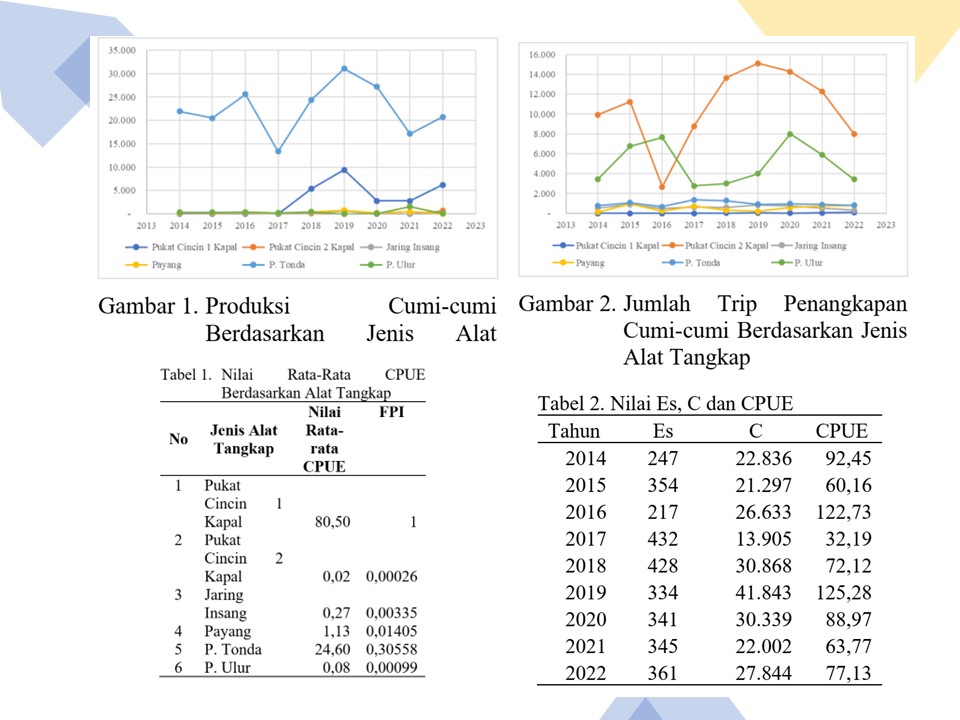Evaluation of the Status of Squid Utilization as a Consideration for the Sustainability of Household Businesses Processing Smoked Squid in Prigi Bay, Trenggalek Regency
DOI:
https://doi.org/10.46252/jsai-fpik-unipa.2024.Vol.8.No.3.434Keywords:
Gordon-Scheafer, squid, overfishing, processed smokeAbstract
Squid is one of the leading export commodities whose potential availability is monitored by the government. This research aims to evaluate the status of squid utilization as a consideration for the sustainability of squid-based smoke processing businesses in Prigi Regency. The analysis used in this research is Gordon-Scheafer bioeconomics. The fishing gear used to catch squid includes 1-boat ring seine, 2-boat ring seine, gill net, paying, trolling line and hand line. The average production of squid commodities from 2014-2022 is 26,396 kg, with a standard effort of 340 yearly trips. Prigi PPN squid fishing activities are economic and biological overfishing because the real average fishing effort exceeds the sum of MEY and MSY efforts. The level of squid utilization tends to approach over-exploited and exceeds 17.5% of the allowable catch. This condition can affect the fulfilment of production needs for processed squid smoke.
Downloads
References
Akbar, A., Rasyid, A., & Nelwan, A. F. P. (2023). The Level of Utilization of Small Pelagic Fish Resources in Buton Regency, Southeast Sulawesi. Torani Journal of Fisheries and Marine Science, 102-118.
Armstrong, C., Kahui, V., Vondolia, G., Aanesen, M., & Czajkowski, M. (2017). Use and non-use values in an applied bioeconomic model of fisheries and habitat connections. Marine Resource Economics, 32(4), 351-369. https://doi.org/10.1086/693477
Awalia, R., Susanto, A., & Aryani, D. (2024). Utilization Rate of Cakalang Fish (Katsuwonus pelamis) in Binuangeun Water, Lebak Regency, Banten Province. Agrikan Jurnal Agribisnis Perikanan, 17(1), 123-130.
Ditya, Y., Mutmainnah, D., Wiadnyana, N., Makmur, S., Kaban, S., Rais, A., … & Koeshendrajana, S. (2022). Assessing the ecosystem approach to fisheries management in indonesian inland fisheries. Polish Journal of Environmental Studies, 31(3), 2579-2588. https://doi.org/10.15244/pjoes/144922
Diop, B., Sanz, N., Duplan, Y., Guene, E., Blanchard, G., Pereau, J., … & Doyen, L. (2018). Maximum economic yield fishery management in the face of global warming. Ecological Economics, 154, 52-61. https://doi.org/10.1016/j.ecolecon.2018.07.027
Fahrudin, A., Wisudo, S., & Juanda, B. (2020). Sustainable development index of marine capture fisheries in indonesia. International Journal of Sustainable Development and Planning, 15(8), 1267-1275. https://doi.org/10.18280/ijsdp.150813
Fuah, R. W., Lase, W. F., Samiaji, J., Rahayu, R., & Riza, F. (2024). Pendugaan Potensi Lestari Ikan Layang Biru (Decapterus macarellus) Di Perairan Sebelah Barat Sumatera Utara. Jurnal Teknologi Perikanan dan Kelautan, 15(1), 93-102.
Indrayani, E., & Fattah, M. (2021). Bioekonomi Perikanan Pendekatan Statis dan Dinamis. UB Press.
Jurado-Molina, J., García-Meléndez, J., & Cortes-Salgado, M. (2021). Development of a stochastic bioeconomic model for the red octopus fishery on the yucatan peninsula: implications for management. Ciencias Marinas, 47(4). https://doi.org/10.7773/cm.v47i4.3206
KKP. (2022). Kelautan Dan Perikanan Dalam Angka Tahun 2022. Pusat Data, Statistik dan Informasi. Jakarta.
Mahmudah, S., Susilowati, E., Yunanto, A., Badriyah, S., & Benuf, K. (2021). The cv as an initiative for sustainable development of small-scale capture fisheries in central java, indonesia. International Journal of Criminology and Sociology, 10, 249-253. https://doi.org/10.6000/1929-4409.2021.10.30
Mariana, R. R., Hidayat, N. W., Andoko, A., Hermanto, Y. A. L., Pahlevi, A. S., & Muntholib, M. (2023). Pengolahan Ikan Asap Berdasarkan Konsep Cara Pengolahan Pangan yang Baik (CPPB) untuk Meningkatkan Branding Kuliner Unggulan Pantai Prigi Trenggalek. Indonesian Journal for Social Responsibility, 5(01), 35-49.
Nataliana, E., Yusnaldi, Y., Yulianto, B., Syamsunasir, S., Widodo, P., Saragih, H., … & Suwarno, P. (2023). Government efforts in realizing legal, reported and regulated capture fisheries in indonesia. International Journal of Humanities Education and Social Sciences (Ijhess), 2(4). https://doi.org/10.55227/ijhess.v2i4.379
Nurulludin, N., Purwoko, R. M., Akbar, M. A., Mahullete, R. T., & Widodo, A. A. (2021). Status Pengelolaan Sumberdaya Cumi-Cumi Di Perairan Samudera Hindia Selatan Jawa Berbasis Di Pelabuhan Perikanan Nusantara Prigi, Trenggalek. Jurnal Penelitian Perikanan Indonesia, 27(4), 229-236.
Purwanti, P., Fattah, M., & Lestariadi, R. A. (2021). Ekonomi Perikanan Pendekatan Generatif dan Ekstraktif. UB Media.
Purwanti, P., Sofiati, D., Intyas, C. A., Fattah, M., Qurrata, V. A., & Saputra, J. (2024). Assessment of the Resources Sustainability Using Resource Utilisation and Catch Projection Approach: Case of Prigi Gulf Indonesia. Journal of Sustainability Science and Management, 19(7), 57–69. https://doi.org/10.46754/jssm.2024.07.004
Rahmawati, M., Fitri, A. D. P., & Wijayanto, D. (2013). Analisis hasil tangkapan per upaya penangkapan dan pola musim penangkapan ikan teri (Stolephorus spp.) di Perairan Pemalang. Journal of fisheries resources utilization management and technology, 2(3), 213-222.
Smith, M. and Wilen, J. (2003). Economic impacts of marine reserves: the importance of spatial behavior. Journal of Environmental Economics and Management, 46(2), 183-206. https://doi.org/10.1016/s0095-0696(03)00024-x
Vondolia, G., Chen, W., Armstrong, C., & Norling, M. (2019). Bioeconomic modelling of coastal cod and kelp forest interactions: co-benefits of habitat services, fisheries and carbon sinks. Environmental and Resource Economics, 75(1), 25-48. https://doi.org/10.1007/s10640-019-00387-y
White, W., Faizah, R., Chodrijah, U., Buckworth, R., & Dichmont, C. (2014). Rapid fishery assessment by market survey (rfams) – an improved rapid-assessment approach to characterising fish landings in developing countries. Plos One, 9(10), e109182. https://doi.org/10.1371/journal.pone.0109182
Wicaksono, B., Sutandi, T., & Tembo, S. (2020). Forecasting fisheries production in indonesia. Jurnal Ekonomi & Studi Pembangunan, 21(2). https://doi.org/10.18196/jesp.21.2.5039

Downloads
Published
How to Cite
Issue
Section
License
Copyright (c) 2024 Pudji Purwanti, Candra Adi Intyas, Dwi Sofiati, Mochammad Fattah, Asyifa Anandya

This work is licensed under a Creative Commons Attribution-ShareAlike 4.0 International License.


















